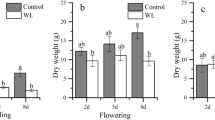Abstract.
In a previous study on the effects of N-supply on leaf cell elongation, the spatial distribution of relative cell elongation rates (RCER), epidermal cell turgor, osmotic pressure (OP) and water potential (Ψ) along the elongation zone of the third leaf of barley was determined (W. Fricke et al. 1997, Planta 202: 522–530). The results suggested that in plants receiving N at fixed relative addition rates (N-supply limitation of growth), cell elongation was rate-limited by the rate of solute provision, whereas in plants growing on complete nutrient solution containing excessive amounts of N (N-demand limitation), cell elongation was rate-limited by the rate of water supply or wall yielding. In the present paper, these suggestions were tested further. The generation rates of cell OP, turgor and Ψ along the elongation zone were calculated by applying the continuity equation of fluid dynamics to the previous data. To allow a more conclusive interpretation of results, anatomical data were collected and bulk solute concentrations determined. The rate of OP generation generally exceeded the rate of turgor generation. As a result, negative values of cell Ψ were created, particularly in demand-limited plants. These plants showed highest RCER along the elongation zone and a Ψ gradient of at least −0.15 MPa between water source (xylem) and expanding epidermal cells. The latter was similar to a theoretically predicted value (−0.18 MPa). Highest rates of OP generation were observed in demand-limited plants, with a maximum rate of 0.112 MPa · h−1 at 16–20 mm from the leaf base. This was almost twice the rate in N-supply-limited plants and implied that the cells in the leaf elongation zone were capable of importing (or synthesising) every minute almost 1 mM of osmolytes. Potassium, Cl− and NO3 − were the main inorganic osmolytes (only determined for demand-limited plants). Their concentrations suggest that, unlike the situation in fully expanded epidermal cells, sugars are used to generate OP and turgor. Anatomical data revealed that the zone of lateral cell expansion extended distally beyond the zone of cell elongation. It is concluded that leaf cell expansion in barley relies on high rates of water and solute supply, rates that may not be sustainable during periods of sufficient N-supply (limitation by water supply: Ψ gradients) or limiting N-supply (limitation by solute provision: reduced OP-generation rates). To minimise the possibility of growth limitation by water and osmolyte provision, longitudinal and lateral cell expansion peak at different locations along the growth zone.
Similar content being viewed by others
Author information
Authors and Affiliations
Additional information
Received: 15 October 1997 / Accepted: 12 March 1998
Rights and permissions
About this article
Cite this article
Fricke, W., Flowers, T. Control of leaf cell elongation in barley. Generation rates of osmotic pressure and turgor, and growth-associated water potential gradients. Planta 206, 53–65 (1998). https://doi.org/10.1007/s004250050373
Issue Date:
DOI: https://doi.org/10.1007/s004250050373




